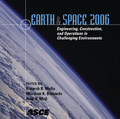''All Up'' Analog Simulations: Why They are Essential for Planning Long Duration Human Missions to the Moon and Mars
Publication: Earth & Space 2006: Engineering, Construction, and Operations in Challenging Environment
Abstract
Long duration human expeditionary missions to the Moon and Mars, such as those currently proposed, will require extensive use of many systems to support exploration and maintain health and safety of the crew. Interaction with these systems for the purpose of control, monitoring and operation will be a full time job whether the crewmembers are in the field (EVA — Extravehicular Activity) or in the habitat (IVA — Intravehicular Activity). Understanding how to coordinate all of the functions and activities that must occur at an expeditionary outpost suggests recreating the same functions and activities at an earth analog site. The analog site includes the habitat/s, all habitat support systems, internal and external, rovers, balloons, science equipment, remote camps, etc., that would be required for an actual mission. This approach differs from analog studies that have been performed to date, as they tend to involve testing of one piece of equipment or one operational modality at a time. Facilities in extreme environments will also be used as precedents for the expeditionary analog. The facilities investigated may include polar outposts (South Pole Station), undersea habitats (Conshelf, Sealab, Tektite), space habitats (Skylab, Salyut, Mir, ISS) and planetary surface bases (the Apollo "J" mission landing sites — Apollo 15, 16 and 17). Study of these facilities may reveal systems and procedures that may be beneficial (or should not be duplicated) at the planetary Earth analog site. The author's experience in design of two (2) analog training facilities (The Antarctic High Station, 1993 and the Flashline Mars Arctic Research Station, 1998 to 2000) will be used to explain the nature of the test facility and the integration of all systems. An analysis of the various systems and the relationships between them and the human users will also serve to demonstrate the possible difficulties inherent in this undertaking and how mission success may be achieved with All-Up analog simulation.
Get full access to this chapter
View all available purchase options and get full access to this chapter.
Information & Authors
Information
Published In
Copyright
© 2006 American Society of Civil Engineers.
History
Published online: Apr 26, 2012
Authors
Metrics & Citations
Metrics
Citations
Download citation
If you have the appropriate software installed, you can download article citation data to the citation manager of your choice. Simply select your manager software from the list below and click Download.
